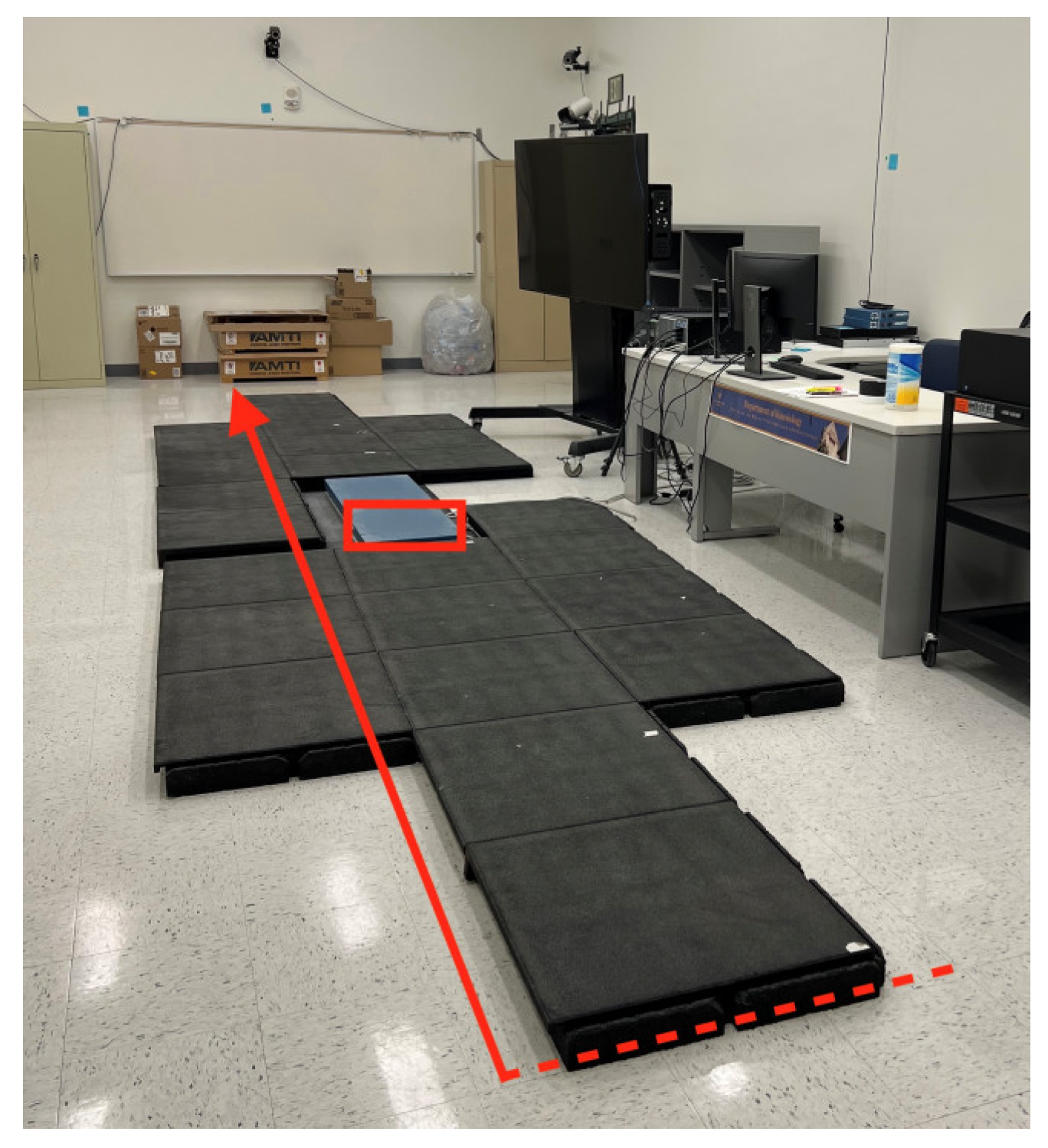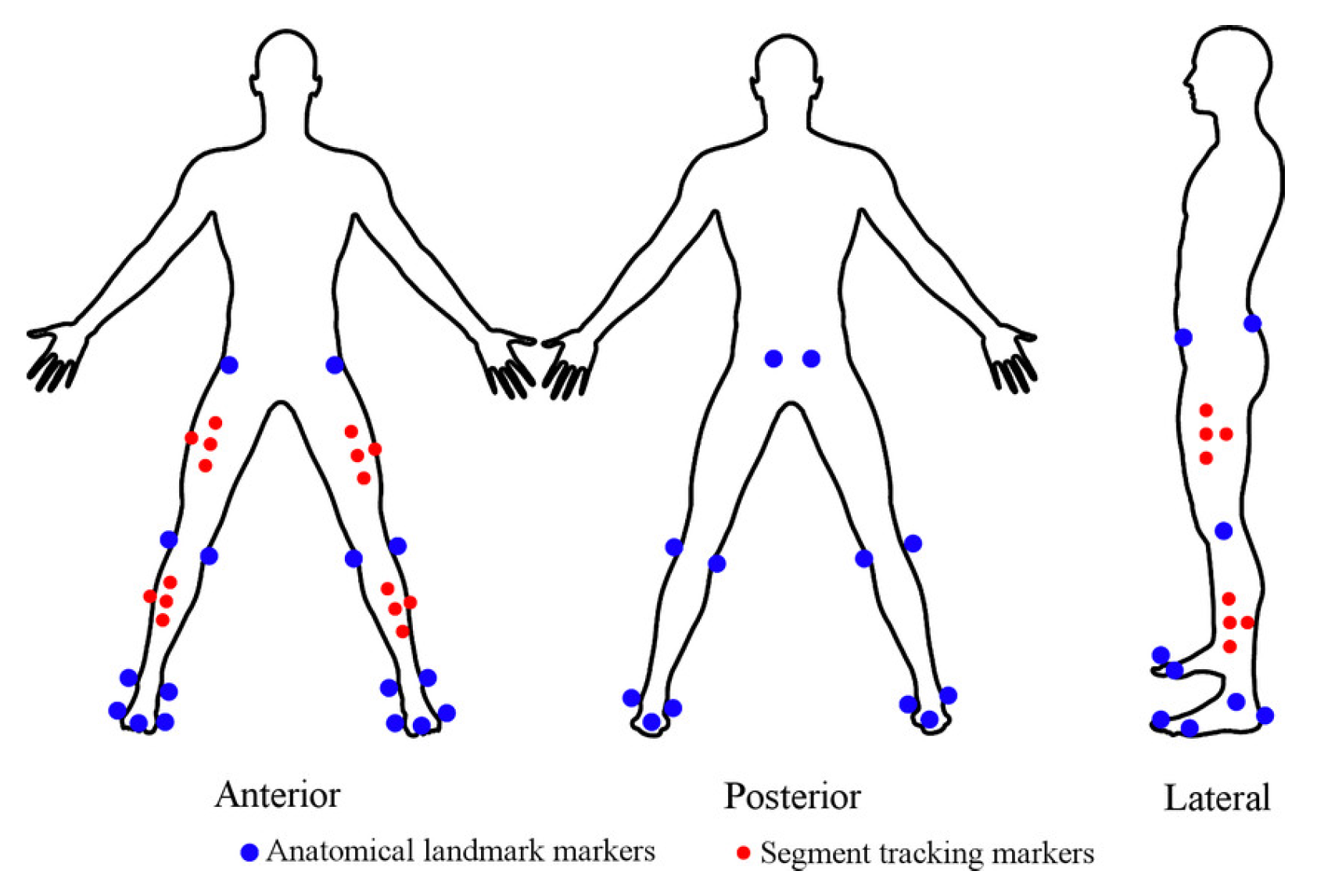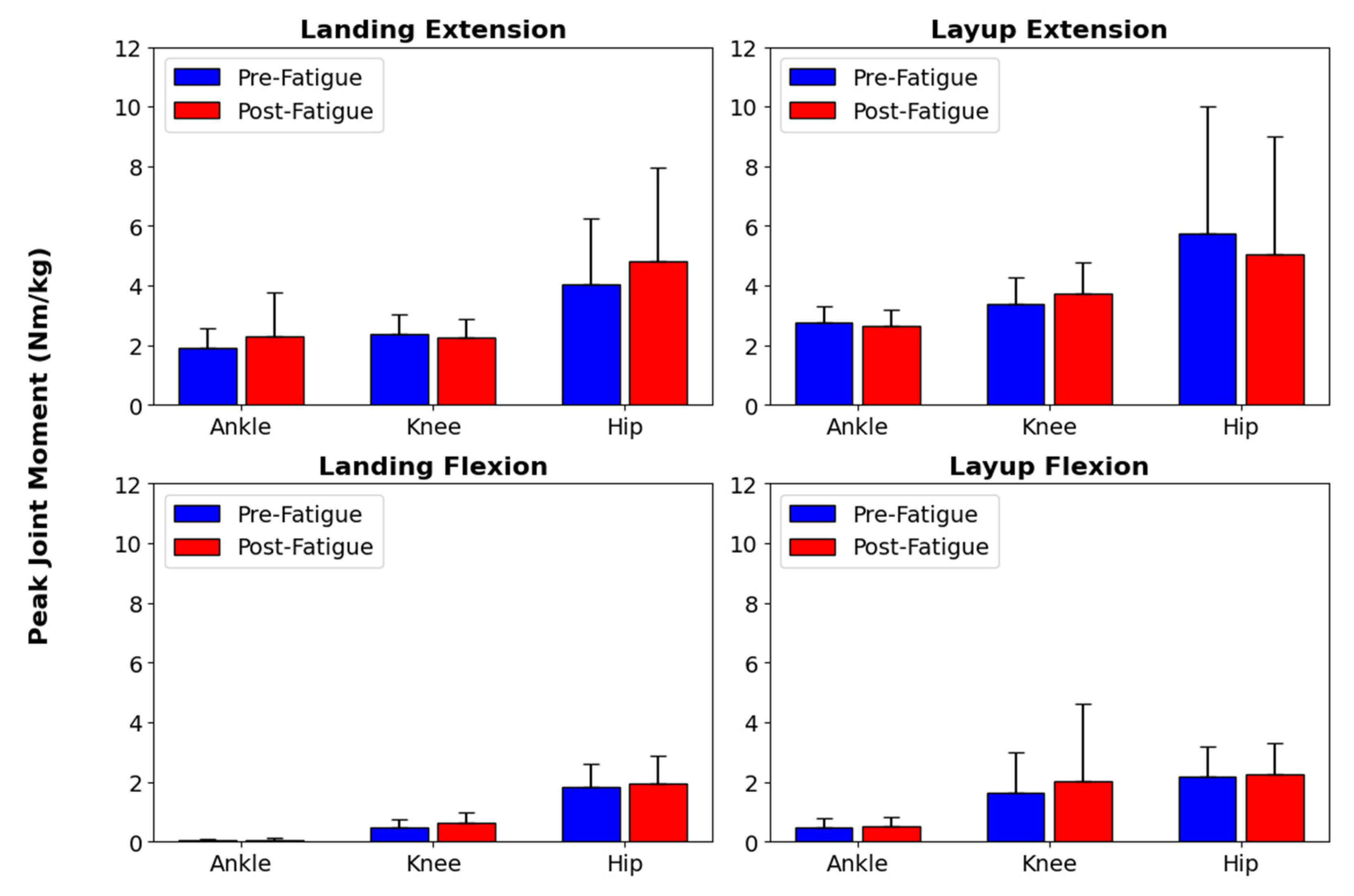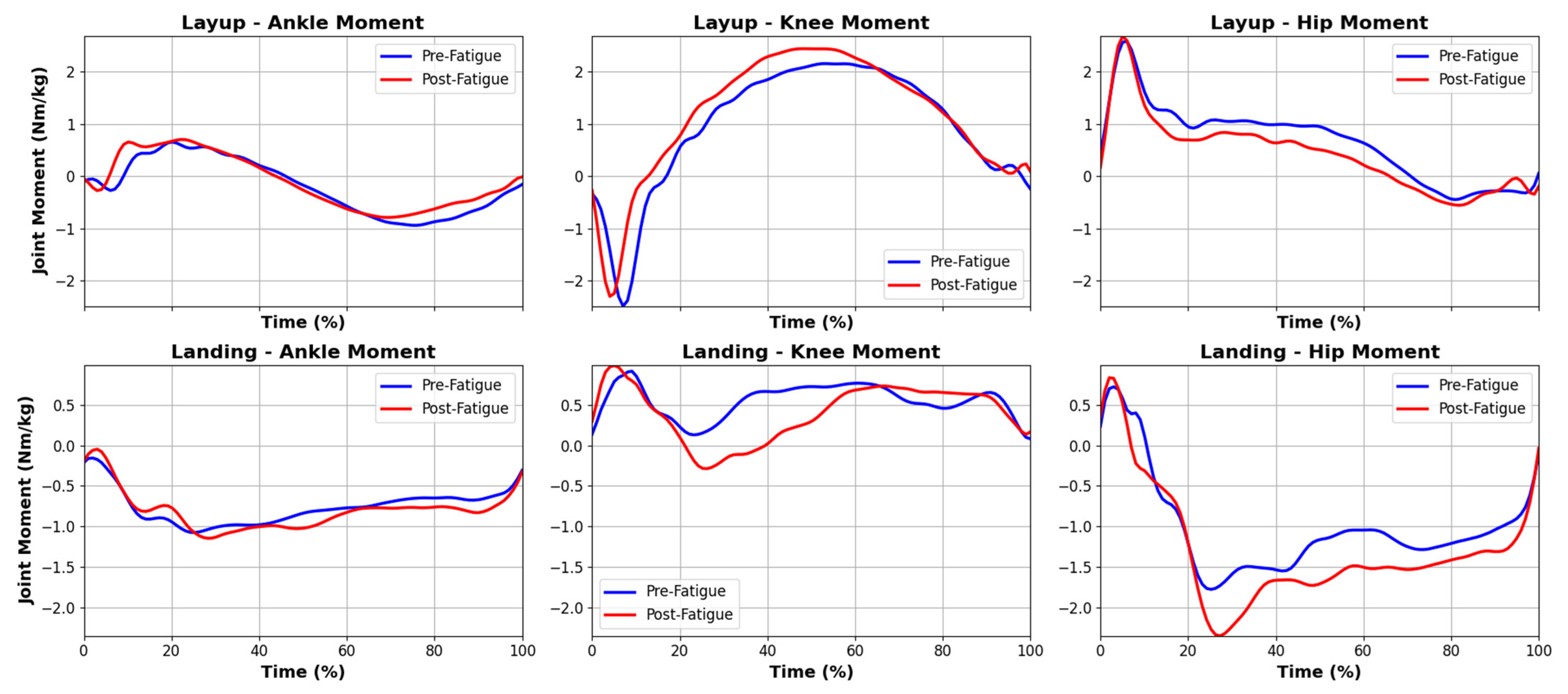The Effects of Muscle Fatigue on Lower Extremity Biomechanics During the Three-Step Layup Jump and Drop Landing in Male Recreational Basketball Players
Abstract
1. Introduction
2. Materials and Methods
2.1. Participants
2.2. Experimental Protocol and Data Collection
2.3. Data Analysis
2.4. Statistical Analysis
3. Results
3.1. Joint Angle
3.2. Joint Moment and Ground Reaction Force
3.3. Joint Power and Work
4. Discussion
5. Conclusions
Author Contributions
Funding
Institutional Review Board Statement
Informed Consent Statement
Data Availability Statement
Acknowledgments
Conflicts of Interest
References
- Pinniger, G.J.; Steele, J.R.; Groeller, H. Does Fatigue Induced by Repeated Dynamic Efforts Affect Hamstring Muscle Function? Med. Sci. Sports Exerc. 2000, 32, 647–653. [Google Scholar] [CrossRef]
- Nyland, J.; Brand, E.; Fisher, B. Update on Rehabilitation Following ACL Reconstruction. Open Access J. Sports Med. 2010, 1, 151–166. [Google Scholar] [CrossRef]
- Dugan, S.A.; Frontera, W.R. Muscle Fatigue and Muscle Injury. Phys. Med. Rehabil. Clin. N. Am. 2000, 11, 385–403. [Google Scholar] [CrossRef]
- Östenberg, A.; Roos, H. Injury Risk Factors in Female European Football. A Prospective Study of 123 Players during One Season. Scand. J. Med. Sci. Sports 2000, 10, 279–285. [Google Scholar] [CrossRef]
- Qu, D.; Zhang, Z.; Yu, X.; Zhao, J.; Qiu, F.; Huang, J. Psychotropic Drugs for the Management of Cancer-Related Fatigue: A Systematic Review and Meta-Analysis. Eur. J. Cancer Care 2016, 25, 970–979. [Google Scholar] [CrossRef] [PubMed]
- Chappell, J.D.; Herman, D.C.; Knight, B.S.; Kirkendall, D.T.; Garrett, W.E.; Yu, B. Effect of Fatigue on Knee Kinetics and Kinematics in Stop-Jump Tasks. Am. J. Sports Med. 2005, 33, 1022–1029. [Google Scholar] [CrossRef] [PubMed]
- Van Der Does, H.T.D.; Brink, M.S.; Benjaminse, A.; Visscher, C.; Lemmink, K.A.P.M. Jump Landing Characteristics Predict Lower Extremity Injuries in Indoor Team Sports. Int. J. Sports Med. 2016, 37, 251–256. [Google Scholar] [CrossRef]
- Wan, J.-J.; Qin, Z.; Wang, P.-Y.; Sun, Y.; Liu, X. Muscle Fatigue: General Understanding and Treatment. Exp. Mol. Med. 2017, 49, 384. [Google Scholar] [CrossRef]
- Griffin, L.Y.; Agel, J.; Albohm, M.J.; Arendt, E.A.; Dick, R.W.; Garrett, W.E.; Garrick, J.G.; Hewett, T.E.; Huston, L.; Ireland, M.L.; et al. Noncontact Anterior Cruciate Ligament Injuries: Risk Factors and Prevention Strategies. J. Am. Acad. Orthop. Surg. 2000, 8, 141–150. [Google Scholar] [CrossRef] [PubMed]
- Simpson, J.D.; Stewart, E.M.; Macias, D.M.; Chander, H.; Knight, A.C. Individuals with Chronic Ankle Instability Exhibit Dynamic Postural Stability Deficits and Altered Unilateral Landing Biomechanics: A Systematic Review. Phys. Ther. Sport 2019, 37, 210–219. [Google Scholar] [CrossRef]
- Verschueren, J.; Tassignon, B.; Pluym, B.; Van Cutsem, J.; Verhagen, E.; Meeusen, R. Bringing Context to Balance: Development of a Reactive Balance Test within the Injury Prevention and Return to Sport Domain. Arch. Physiother. 2019, 9, 6. [Google Scholar] [CrossRef] [PubMed]
- Liederbach, M.; Kremenic, I.J.; Orishimo, K.F.; Pappas, E.; Hagins, M. Comparison of Landing Biomechanics between Male and Female Dancers and Athletes, Part 2: Influence of Fatigue and Implications for Anterior Cruciate Ligament Injury. Am. J. Sports Med. 2014, 42, 1089–1095. [Google Scholar] [CrossRef]
- Wong, T.L.; Huang, C.F.; Chen, P.C. Effects of Lower Extremity Muscle Fatigue on Knee Loading During a Forward Drop Jump to a Vertical Jump in Female Athletes. J. Hum. Kinet. 2020, 72, 5. [Google Scholar] [CrossRef]
- Xu, D.; Cen, X.; Wang, M.; Rong, M.; István, B.; Baker, J.S.; Gu, Y. Temporal Kinematic Differences between Forward and Backward Jump-Landing. Int. J. Environ. Res. Public Health 2020, 17, 6669. [Google Scholar] [CrossRef]
- Wang, L.; Ye, J.; Zhang, X. Ankle Biomechanics of the Three-Step Layup in a Basketball Player with Chronic Ankle Instability. Sci. Rep. 2023, 13, 18667. [Google Scholar] [CrossRef]
- Trounson, K.M.; Busch, A.; Collier, N.F.; Robertson, S. Effects of Acute Wearable Resistance Loading on Overground Running Lower Body Kinematics. PLoS ONE 2020, 15, e0244361. [Google Scholar] [CrossRef]
- Rácz, K.; Kiss, R.M. Marker Displacement Data Filtering in Gait Analysis: A Technical Note. Biomed. Signal Process Control 2021, 70, 102974. [Google Scholar] [CrossRef]
- Challis, J.H. A Procedure for the Automatic Determination of Filter Cutoff Frequency for the Processing of Biomechanical Data. J. Appl. Biomech. 1999, 15, 303–317. [Google Scholar] [CrossRef]
- Russell Esposito, E.; Choi, H.S.; Owens, J.G.; Blanck, R.V.; Wilken, J.M. Biomechanical Response to Ankle-Foot Orthosis Stiffness during Running. Clin. Biomech. 2015, 30, 1125–1132. [Google Scholar] [CrossRef] [PubMed]
- Russell Esposito, E.; Ranz, E.C.; Schmidtbauer, K.A.; Neptune, R.R.; Wilken, J.M. Ankle-Foot Orthosis Bending Axis Influences Running Mechanics. Gait Posture 2017, 56, 147–152. [Google Scholar] [CrossRef] [PubMed]
- Russell Esposito, E.; Blanck, R.V.; Harper, N.G.; Hsu, J.R.; Wilken, J.M. How Does Ankle-Foot Orthosis Stiffness Affect Gait in Patients with Lower Limb Salvage? Clin. Orthop. Relat. Res. 2014, 472, 3026–3035. [Google Scholar] [CrossRef]
- Jin, L.; Hahn, M.E. Modulation of Lower Extremity Joint Stiffness, Work and Power at Different Walking and Running Speeds. Hum. Mov. Sci. 2018, 58, 1–9. [Google Scholar] [CrossRef]
- Jin, L.; Hahn, M.E. Comparison of Lower Extremity Joint Mechanics between Healthy Active Young and Middle Age People in Walking and Running Gait. Sci. Rep. 2019, 9, 5568. [Google Scholar] [CrossRef]
- Jin, L.; Hahn, M.E. Lower Extremity Joint Kinetics during Walk-to-Run and Run-to-Walk Transitions. Biomechanics 2024, 4, 246–258. [Google Scholar] [CrossRef]
- Webster, K.E.; Santamaria, L.J.; McClelland, J.A.; Feller, J.A. Effect of Fatigue on Landing Biomechanics after Anterior Cruciate Ligament Reconstruction Surgery. Med. Sci. Sports Exerc. 2012, 44, 910–916. [Google Scholar] [CrossRef] [PubMed]
- Fagenbaum, R.; Darling, W.G. Jump Landing Strategies in Male and Female College Athletes and the Implications of Such Strategies for Anterior Cruciate Ligament Injury. Am. J. Sports Med. 2003, 31, 233–240. [Google Scholar] [CrossRef]
- Ortiz, A.; Olson, S.L.; Etnyre, B.; Trudelle-Jackson, E.E.; Bartlett, W.; Venegas-Rios, H.L. Fatigue Effects on Knee Joint Stability During Two Jump Tasks in Women. J. Strength Cond. Res./Natl. Strength Cond. Assoc. 2010, 24, 1019–1027. [Google Scholar] [CrossRef] [PubMed]
- Zhang, L.; Yan, Y.; Liu, G.; Han, B.; Fei, J.; Zhang, Y. Effect of Fatigue on Kinematics, Kinetics and Muscle Activities of Lower Limbs during Gait. Proc. Inst. Mech. Eng. H 2022, 236, 1365–1374. [Google Scholar] [CrossRef]
- Hietamo, J.; Pasanen, K.; Leppänen, M.; Steffen, K.; Kannus, P.; Heinonen, A.; Mattila, V.; Parkkari, J. Association between Lower Extremity Muscle Strength and Acute Ankle Injury in Youth Team-Sports Athletes. Phys. Ther. Sport. 2021, 48, 188–195. [Google Scholar] [CrossRef]
- Ishøi, L.; Krommes, K.; Husted, R.S.; Juhl, C.B.; Thorborg, K. Diagnosis, Prevention and Treatment of Common Lower Extremity Muscle Injuries in Sport-Grading the Evidence: A Statement Paper Commissioned by the Danish Society of Sports Physical Therapy (DSSF). Br. J. Sports Med. 2020, 54, 528–537. [Google Scholar] [CrossRef]
- Almousa, S.; Mullen, R.; Williams, K.; Bourne, M.; Williams, M. Identification of Potential Risk Factors for Lower Limb Injuries in Female Team-Sport Athletes: A Prospective Cohort Study. Sci. Med. Footb. 2024, 8, 126–137. [Google Scholar] [CrossRef] [PubMed]
- Li, L.; Baur, M.; Baldwin, K.; Kuehn, T.; Zhu, Q.; Herman, D.; Dai, B. Falling as a Strategy to Decrease Knee Loading during Landings: Implications for ACL Injury Prevention. J. Biomech. 2020, 109, 109906. [Google Scholar] [CrossRef] [PubMed]
- Puddle, D.L.; Maulder, P.S. Ground Reaction Forces and Loading Rates Associated with Parkour and Traditional Drop Landing Techniques. J. Sports Sci. Med. 2013, 12, 122. [Google Scholar] [PubMed]






| Joint Angle (Degree) | Fatigue Condition, Mean (SD), Percentage Difference, p-Value | |||
|---|---|---|---|---|
| Pre-Fatigue | Post-Fatigue | Percentage Difference (%) | p-Value | |
| Landing | ||||
| Peak Ankle Dorsi Flexion | 5.36 (7.51) | 4.98 (6.82) | 7.35 | 0.543 |
| Peak Ankle Plantar Flexion | 48.83 (6.10) | 47.27 (7.88) | 3.25 | 0.314 |
| Peak Knee Flexion | 50.08 (11.98) | 51.33 (10.34) | 2.47 | 0.297 |
| Peak Knee Extension | 8.00 (4.90) | 9.31 (5.04) | 15.14 | 0.124 |
| Peak Hip Flexion | 30.18 (10.24) | 31.71 (12.87) | 4.94 | 0.315 |
| Peak Hip Extension | 12.01 (7.07) | 10.93 (7.10) | 9.42 | 0.337 |
| Layup | ||||
| Peak Ankle Dorsi Flexion | 4.03 (6.13) | 3.39 (5.37) | 17.25 | 0.179 |
| Peak Ankle Plantar Flexion | 55.90 (7.79) | 53.97 (5.46) | 3.51 | 0.062 |
| Peak Knee Flexion | 56.75 (12.78) | 58.98 (12.46) | 3.85 | 0.460 |
| Peak Knee Extension | 6.75 (6.01) | 9.28 (6.52) | 31.57 | 0.028 |
| Peak Hip Flexion | 59.24 (8.23) | 59.00 (6.46) | 0.41 | 0.861 |
| Peak Hip Extension | 1.62 (1.01) | 1.6 (1.26) | 1.24 | 0.950 |
| Kinetic Variables | Fatigue Condition, Mean (SD), Percentage Difference, p-Value | |||
|---|---|---|---|---|
| Pre-Fatigue | Post-Fatigue | Percentage Difference (%) | p-Value | |
| Landing | ||||
| Peak Vertical Ground Reaction Forces | 3.41 (0.81) | 3.95 (1.10) | 14.67 | 0.036 * |
| Peak Ankle Dorsi Flexion Moment | 0.05 (0.04) | 0.06 (0.05) | 18.18 | 0.086 |
| Peak Ankle Plantar Flexion Moment | 1.93 (0.65) | 2.31 (1.45) | 17.92 | 0.299 |
| Peak Knee Flexion Moment | 0.47 (0.29) | 0.62 (0.34) | 27.52 | 0.221 |
| Peak Knee Extension Moment | 2.38 (0.66) | 2.28 (0.60) | 4.29 | 0.423 |
| Peak Hip Flexion Moment | 1.82 (0.78) | 1.93 (0.93) | 5.87 | 0.481 |
| Peak Hip Extension Moment | 4.06 (2.20) | 4.81 (3.14) | 16.91 | 0.269 |
| Layup | ||||
| Peak Vertical Ground Reaction Force | 3.25 (0.51) | 3.13 (0.60) | 3.76 | 0.452 |
| Peak Ankle Dorsi Flexion Moment | 0.47 (0.32) | 0.50 (0.34) | 6.19 | 0.627 |
| Peak Ankle Plantar Flexion Moment | 2.78 (0.53) | 2.66 (0.52) | 4.41 | 0.295 |
| Peak Knee Flexion Moment | 1.63 (1.36) | 2.02 (2.61) | 21.37 | 0.421 |
| Peak Knee Extension Moment | 3.38 (0.88) | 3.72 (1.07) | 9.58 | 0.327 |
| Peak Hip Flexion Moment | 2.19 (0.98) | 2.27 (1.05) | 3.59 | 0.374 |
| Peak Hip Extension Moment | 5.73 (4.27) | 5.04 (3.95) | 12.81 | 0.414 |
| Peak Joint Power (W/kg) | Fatigue Condition, Mean (SD), Percentage Difference, p-Value | |||
|---|---|---|---|---|
| Pre-Fatigue | Post-Fatigue | Percentage Difference (%) | p-Value | |
| Landing | ||||
| Peak Positive Ankle Power | 2.08 (1.40) | 2.98 (3.47) | 35.57 | 0.362 |
| Peak Positive Knee Power | 2.77 (1.03) | 3.98 (2.67) | 35.83 | 0.081 |
| Peak Positive Hip Power | 2.14 (1.06) | 2.58 (1.72) | 18.64 | 0.116 |
| Peak Negative Ankle Power | 9.95 (2.96) | 9.86 (4.56) | 0.91 | 0.938 |
| Peak Negative Knee Power | 11.48 (5.92) | 11.65 (5.28) | 1.47 | 0.834 |
| Peak Negative Hip Power | 11.27 (11.56) | 12.47 (8.87) | 10.11 | 0.413 |
| Layup | ||||
| Peak Positive Ankle Power | 17.66 (5.48) | 18.04 (4.79) | 2.13 | 0.801 |
| Peak Positive Knee Power | 14.95 (6.38) | 16.09 (7.00) | 7.35 | 0.527 |
| Peak Positive Hip Power | 13.18 (11.33) | 12.36 (8.88) | 6.42 | 0.611 |
| Peak Negative Ankle Power | 4.15 (1.70) | 4.27 (1.75) | 2.85 | 0.677 |
| Peak Negative Knee Power | 7.90 (2.86) | 9.75 (5.20) | 20.96 | 0.149 |
| Peak Negative Hip Power | 12.64 (6.63) | 10.96 (11.37) | 14.2 | 0.602 |
| Mechanical Work (J/kg) | Fatigue Condition, Mean (SD), Percentage Difference, p-Value | |||
|---|---|---|---|---|
| Pre-Fatigue | Post-Fatigue | Percentage Difference (%) | p-Value | |
| Landing | ||||
| Positive Ankle Joint Work | 0.18 (0.12) | 0.25 (0.17) | 32.56 | 0.167 |
| Positive Knee Joint Work | 0.27 (0.16) | 0.30 (0.15) | 10.53 | 0.236 |
| Positive Hip Joint Work | 0.23 (0.22) | 0.29 (0.24) | 23.08 | 0.031 |
| Negative Ankle Joint Work | 0.68 (0.26) | 0.69 (0.23) | 1.46 | 0.913 |
| Negative Knee Joint Work | 0.72 (0.36) | 0.63 (0.61) | 13.33 | 0.498 |
| Negative Hip Joint Work | 0.34 (0.18) | 0.66 (0.43) | 64 | 0.025 * |
| Layup | ||||
| Positive Ankle Joint Work | 1.13 (0.37) | 1.09 (0.31) | 3.60 | 0.585 |
| Positive Knee Joint Work | 1.07 (0.44) | 1.04 (0.54) | 2.84 | 0.866 |
| Positive Hip Joint Work | 0.83 (0.53) | 0.68 (0.30) | 19.87 | 0.214 |
| Negative Ankle Joint Work | 0.29 (0.13) | 0.26 (0.11) | 10.91 | 0.346 |
| Negative Knee Joint Work | 0.65 (0.22) | 0.73 (0.28) | 11.59 | 0.193 |
| Negative Hip Joint Work | 0.79 (0.46) | 0.92 (0.53) | 15.20 | 0.078 |
Disclaimer/Publisher’s Note: The statements, opinions and data contained in all publications are solely those of the individual author(s) and contributor(s) and not of MDPI and/or the editor(s). MDPI and/or the editor(s) disclaim responsibility for any injury to people or property resulting from any ideas, methods, instructions or products referred to in the content. |
© 2025 by the authors. Licensee MDPI, Basel, Switzerland. This article is an open access article distributed under the terms and conditions of the Creative Commons Attribution (CC BY) license (https://creativecommons.org/licenses/by/4.0/).
Share and Cite
Jin, L.; Yang, B. The Effects of Muscle Fatigue on Lower Extremity Biomechanics During the Three-Step Layup Jump and Drop Landing in Male Recreational Basketball Players. Biomechanics 2025, 5, 81. https://doi.org/10.3390/biomechanics5040081
Jin L, Yang B. The Effects of Muscle Fatigue on Lower Extremity Biomechanics During the Three-Step Layup Jump and Drop Landing in Male Recreational Basketball Players. Biomechanics. 2025; 5(4):81. https://doi.org/10.3390/biomechanics5040081
Chicago/Turabian StyleJin, Li, and Brandon Yang. 2025. "The Effects of Muscle Fatigue on Lower Extremity Biomechanics During the Three-Step Layup Jump and Drop Landing in Male Recreational Basketball Players" Biomechanics 5, no. 4: 81. https://doi.org/10.3390/biomechanics5040081
APA StyleJin, L., & Yang, B. (2025). The Effects of Muscle Fatigue on Lower Extremity Biomechanics During the Three-Step Layup Jump and Drop Landing in Male Recreational Basketball Players. Biomechanics, 5(4), 81. https://doi.org/10.3390/biomechanics5040081






